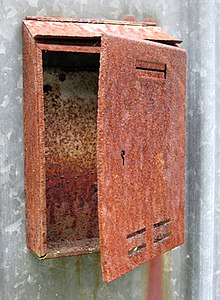

This article needs additional citations for verification. Please help improve this articlebyadding citations to reliable sources. Unsourced material may be challenged and removed.
Find sources: "Hot-dip galvanization" – news · newspapers · books · scholar · JSTOR (November 2013) (Learn how and when to remove this message) |



Hot-dip galvanization is a form of galvanization. It is the process of coating iron and steel with zinc, which alloys with the surface of the base metal when immersing the metal in a bath of molten zinc at a temperature of around 450 °C (842 °F). When exposed to the atmosphere, the pure zinc (Zn) reacts with oxygen (O2) to form zinc oxide (ZnO), which further reacts with carbon dioxide (CO2) to form zinc carbonate (ZnCO3), a usually dull grey, fairly strong material that protects the steel underneath from further corrosion in many circumstances. Galvanized steel is widely used in applications where corrosion resistance is needed without the cost of stainless steel, and is considered superior in terms of cost and life-cycle. It can be identified by the crystallization patterning on the surface (often called a "spangle").[1]
Galvanized steel can be welded; however, one must exercise caution around the resulting toxic zinc fumes. Galvanized fumes are released when the galvanized metal reaches a certain temperature. This temperature varies by the galvanization process used. In long-term, continuous exposure, the recommended maximum temperature for hot-dip galvanized steel is 200 °C (392 °F), according to the American Galvanizers Association. The use of galvanized steel at temperatures above this will result in peeling of the zinc at the inter-metallic layer[citation needed]. Electrogalvanized sheet steel is often used in automotive manufacturing to enhance the corrosion performance of exterior body panels; this is, however, a completely different process which tends to achieve lower coating thicknesses of zinc.
Like other corrosion protection systems, galvanizing protects steel by acting as a barrier between steel and the atmosphere. However, zinc is a more electropositive (active) metal in comparison to steel. This is a unique characteristic for galvanizing, which means that when a galvanized coating is damaged and steel is exposed to the atmosphere, zinc can continue to protect steel through galvanic corrosion (often within an annulus of 5 mm, above which electron transfer rate decreases).
The process of hot-dip galvanizing results in a metallurgical bond between zinc and steel, with a series of distinct iron-zinc alloys. The resulting coated steel can be used in much the same way as uncoated.
A typical hot-dip galvanizing line operates as follows:[2]
Lead is often added to the molten zinc bath to improve the fluidity of the bath (thus limiting excess zinc on the dipped product by improved drainage properties), help prevent floating dross, make dross recycling easier and protect the kettle from uneven heat distribution from the burners. Environmental regulations in the United States disapprove of lead in the kettle bath. Lead is either added to primary Z1 grade zinc or already contained in used secondary zinc. A third, declining method is to use low Z5 grade zinc.[3]
Steel strip can be hot-dip galvanized in a continuous line. Hot-dip galvanized steel strip (also sometimes loosely referred to as galvanized iron) is extensively used for applications requiring the strength of steel combined with the resistance to corrosion of zinc, such as roofing and walling, safety barriers, handrails, consumer appliances and automotive body parts. One common use is in metal pails. Galvanised steel is also used in most heating and cooling duct systems in buildings
Individual metal articles, such as steel girders or wrought iron gates, can be hot-dip galvanized by a process called batch galvanizing. Other modern techniques have largely replaced hot-dip for these sorts of roles. This includes electrogalvanizing, which deposits the layer of zinc from an aqueous electrolyte by electroplating, forming a thinner and much stronger bond.
In 1742, French chemist Paul Jacques Malouin described a method of coating iron by dipping it in molten zinc in a presentation to the French Royal Academy.
In 1772, Luigi Galvani (Italy), for whom galvanizing was named, discovered the electrochemical process that takes place between metals during an experiment with frog legs.
In 1801, Alessandro Volta furthered the research on galvanizing when he discovered the electro-potential between two metals, creating a corrosion cell.
In 1836, French chemist Stanislas Sorel obtained a patent for a method of coating iron with zinc, after first cleaning it with 9% sulfuric acid (H2SO4) and fluxing it with ammonium chloride (NH4Cl).
A hot-dip galvanized coating is relatively easier and cheaper to specify than an organic paint coating of equivalent corrosion protection performance. The British, European and International standard for hot-dip galvanizing is BS EN ISO 1461, which specifies a minimum coating thickness to be applied to steel in relation to the steels section thickness e.g. a steel fabrication with a section size thicker than 6 mm shall have a minimum galvanized coating thickness of 85 μm.
Further performance and design information for galvanizing can be found in BS EN ISO 14713-1 and BS EN ISO 14713-2. The durability performance of a galvanized coating depends solely on the corrosion rate of the environment in which it is placed. Corrosion rates for different environments can be found in BS EN ISO 14713-1, where typical corrosion rates are given, along with a description of the environment in which the steel would be used.
| Authority control databases: National |
|
|---|